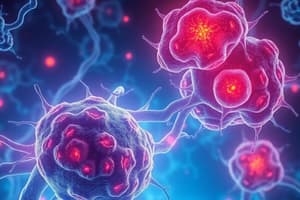Podcast
Questions and Answers
What role do pro-angiogenic factors play in tumor growth?
What role do pro-angiogenic factors play in tumor growth?
- They act as a barrier preventing tumor invasion.
- They induce apoptosis in surrounding stroma.
- They inhibit tumor cell proliferation.
- They promote tumor growth by increasing blood supply. (correct)
Which enzyme is primarily involved in the invasion of organ stroma by tumor cells?
Which enzyme is primarily involved in the invasion of organ stroma by tumor cells?
- Protease-activated receptor (PAR)
- Matrix metalloproteinase-9 (MMP9) (correct)
- Matrix metalloproteinase-2 (MMP2)
- Tissue plasminogen activator (tPA)
What does the 'seed and soil' hypothesis suggest about metastasis?
What does the 'seed and soil' hypothesis suggest about metastasis?
- Certain tumor cells have an affinity for specific organ microenvironments. (correct)
- Metastasis occurs randomly without any preference.
- All metastases are driven by genetic mutations.
- Tumor cells have an inherent ability to survive any environment.
What must tumor cells do to successfully enter circulation?
What must tumor cells do to successfully enter circulation?
What two main factors influence the mechanics of metastasis?
What two main factors influence the mechanics of metastasis?
Which hallmark of cancer allows tumors to grow independently of external growth signals?
Which hallmark of cancer allows tumors to grow independently of external growth signals?
What role do mutations in oncogenes generally play in cancer development?
What role do mutations in oncogenes generally play in cancer development?
Which of the following is NOT one of the newly proposed hallmarks of cancer in the update published in 2011?
Which of the following is NOT one of the newly proposed hallmarks of cancer in the update published in 2011?
What is the effect of RAS mutations in human cancers?
What is the effect of RAS mutations in human cancers?
What underlying factor contributes to the acquisition of hallmark traits in tumors?
What underlying factor contributes to the acquisition of hallmark traits in tumors?
Which component of the tumor microenvironment contributes to the development of hallmark traits?
Which component of the tumor microenvironment contributes to the development of hallmark traits?
In the context of cancer, what is the significance of genome instability?
In the context of cancer, what is the significance of genome instability?
Which of the following processes is most likely disrupted in cancer cells leading to uncontrolled growth?
Which of the following processes is most likely disrupted in cancer cells leading to uncontrolled growth?
What characterizes benign tumors compared to malignant tumors?
What characterizes benign tumors compared to malignant tumors?
What is the primary distinction between invasion and metastasis in cancer?
What is the primary distinction between invasion and metastasis in cancer?
Which of the following best describes the term 'carcinogenesis'?
Which of the following best describes the term 'carcinogenesis'?
During which phase of multistep carcinogenesis does a permanent change in DNA occur?
During which phase of multistep carcinogenesis does a permanent change in DNA occur?
Which of the following is NOT considered a promoter in the promotion phase of carcinogenesis?
Which of the following is NOT considered a promoter in the promotion phase of carcinogenesis?
What is the correct sequence of steps in multistep carcinogenesis?
What is the correct sequence of steps in multistep carcinogenesis?
What is the main risk associated with malignant tumors?
What is the main risk associated with malignant tumors?
Which characteristic is true for malignant tumors?
Which characteristic is true for malignant tumors?
Which tumor marker is specifically associated with prostate cancer?
Which tumor marker is specifically associated with prostate cancer?
What is the primary purpose of Polymerase Chain Reaction (PCR) in cancer diagnosis?
What is the primary purpose of Polymerase Chain Reaction (PCR) in cancer diagnosis?
Which of the following best describes the function of Carcinoembryonic antigen (CEA)?
Which of the following best describes the function of Carcinoembryonic antigen (CEA)?
Which technique would be most appropriate for detecting genetic changes in cancer cells?
Which technique would be most appropriate for detecting genetic changes in cancer cells?
What is a main application of Next-generation sequencing (NGS) in cancer therapy?
What is a main application of Next-generation sequencing (NGS) in cancer therapy?
Which option correctly identifies an application of molecular techniques in cancer treatment?
Which option correctly identifies an application of molecular techniques in cancer treatment?
Which of the following is NOT a product of tumors that can be used as a tumor marker?
Which of the following is NOT a product of tumors that can be used as a tumor marker?
Which carcinogen is known to cause adenocarcinoma of the lung?
Which carcinogen is known to cause adenocarcinoma of the lung?
Which dietary factors are linked to an increased risk of certain cancers?
Which dietary factors are linked to an increased risk of certain cancers?
How does regular physical activity impact cancer risk?
How does regular physical activity impact cancer risk?
What is one of the key components of tobacco smoke that contributes to cancer risk?
What is one of the key components of tobacco smoke that contributes to cancer risk?
Which type of radiation is NOT considered a manmade source of cancer risk?
Which type of radiation is NOT considered a manmade source of cancer risk?
Which occupational exposure is primarily associated with bladder cancer?
Which occupational exposure is primarily associated with bladder cancer?
What is the main reason infectious agents can lead to cancer?
What is the main reason infectious agents can lead to cancer?
Which group of individuals is at higher risk for melanoma due to ultraviolet exposure?
Which group of individuals is at higher risk for melanoma due to ultraviolet exposure?
What percentage of cancer deaths is attributed to tobacco use?
What percentage of cancer deaths is attributed to tobacco use?
Flashcards are hidden until you start studying
Study Notes
Benign Tumors
- Relatively harmless in terms of microscopic and macroscopic characteristics
- Remain localized and do not spread
- Easily managed with surgical removal
- Patients generally survive
- Can still cause significant morbidity and even death
Malignant Tumors
- Also known as cancers
- Can invade and destroy surrounding tissues
- Can spread to distant sites (metastasize)
- Often lead to death
Invasion & Metastasis
- Abnormal cancer cells proliferate and spread
- Invasion: Direct migration and penetration into surrounding tissues
- Metastasis: Cancer cells spread through the lymphatic system and blood vessels
Multistep Carcinogenesis
- Initiation: A carcinogen causes permanent DNA change
- Promotion: The initiated cell is stimulated to grow by a promoter. Examples include alcohol, high estrogen, dietary fat, etc.
- Progression & Malignancy: A pre-neoplastic cell acquires additional mutations leading to invasive cancer.
Metastasis
- Seed and soil hypothesis: Certain tumor cells have an affinity for specific organs based on the organ's environment. This explains why metastases occur in specific locations.
Metastasis Factors
- Vascularization: Primary tumors grow through the synthesis and secretion of pro-angiogenic factors.
- Invasion of the organ stroma: Cells enhance expression of enzymes like MMP9 to invade.
- Invasion of lymphatic or vascular channels: Cancer cells enter the circulatory system.
- Survival in circulation: Cells must survive the turbulence of blood flow and evade immune and non-immune mechanisms.
- Arrest in capillary beds: Cells stop in the capillaries of distant organs.
- Extravasation: Cells move out of the blood vessels into the distant organ.
- Survival and proliferation: Tumor cells need a compatible environment to survive and multiply.
Cancer Risk Factors
- Diet: High intake of red and processed meats, salted foods, and low consumption of fruits and vegetables increase cancer risks.
- Physical activity: Regular physical activity can reduce the risks of developing colon, breast, and endometrial cancers.
- Tobacco: Contains carcinogens that cause various types of cancer.
- Ionizing radiation: Man-made sources of radiation like radon, x-rays, and gamma rays can cause cancer. Exposure to UV radiation from the sun or tanning beds can lead to skin cancer.
- Workplace hazards: Exposure to certain chemicals or substances like asbestos can increase cancer risks.
- Infection: Infectious agents like viruses can cause changes in cells that increase the risk of cancer.
Hallmarks of Cancer
- Sustaining proliferative signaling: Tumors can proliferate without external stimuli.
- Evading growth suppressors: Cancer cells bypass normal growth-regulating mechanisms.
- Resisting cell death: Cancer cells avoid programmed cell death (apoptosis).
- Enabling replicative immortality: Cancer cells evade mechanisms that limit cell division.
- Inducing angiogenesis: Tumors create new blood vessels to supply nutrients and oxygen.
- Activating invasion and metastasis: Cancer cells spread to other parts of the body.
- Genome instability: Mutations accumulate rapidly, driving the development of cancer.
- Inflammation: Inflammation can promote cancer development.
Self-Sufficiency in Growth Signals
- Oncogenes: Mutations in proto-oncogenes convert them to oncogenes, which encode oncoproteins that promote cell growth.
- Growth factors: Cancer cells may secrete their own growth factors or induce other cells to produce them.
Tumor Markers
- Prostate-specific antigen (PSA): Prostate cancer
- Cancer antigen 125 (CA125): Ovarian cancer
- Alpha-fetoprotein (AFP): Liver and testicular cancer
- Carcinoembryonic antigen (CEA): Lung, stomach, colon, ovarian and breast
- Carbohydrate antigen 19-9 (CA19-9): Pancreatic, gallbladder, and stomach cancers
Molecular Diagnosis
- Polymerase Chain Reaction (PCR): Detects and amplifies specific DNA sequences associated with cancer.
- Fluorescence in situ hybridization (FISH): Detects genetic changes and chromosomal abnormalities.
- Gene sequencing: Identifies mutations and other genetic changes.
- Next-generation sequencing (NGS): Advanced method of reading DNA for rapid analysis of genetic changes.
Molecular Diagnosis Applications
- Diagnosis of malignancy
- Prognosis and behavior prediction
- Detection of minimal residual disease
- Diagnosis of hereditary predisposition to cancer
- Therapeutic decision-making
Studying That Suits You
Use AI to generate personalized quizzes and flashcards to suit your learning preferences.



